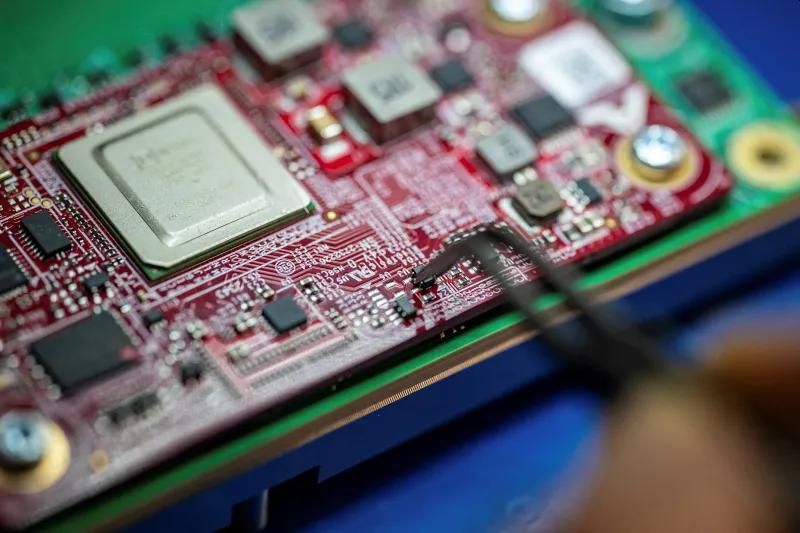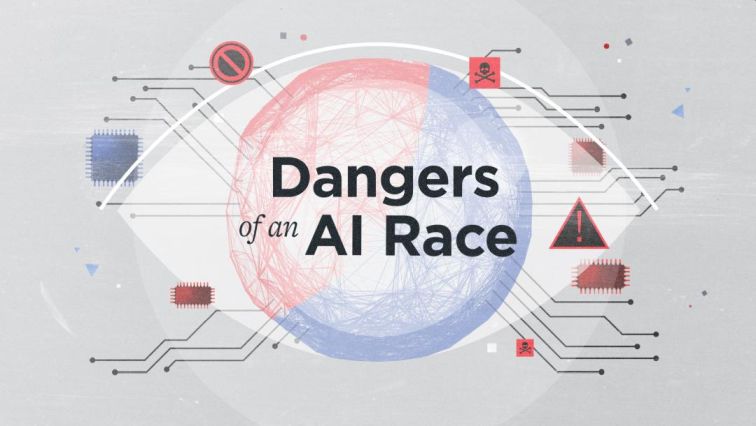By Eric Vandenbroeck and co-workers
The Real Stakes of the AI Race
A sense that global
technology competition is becoming a zero-sum game, and that the remainder of the
twenty-first century will be made in the winner’s image, pervades in
Washington, Beijing, and boardrooms worldwide. This angst feeds ambitious
industrial policies, precautionary regulations, and multibillion-dollar
investments. Yet even as governments and private industry race for supremacy in
artificial intelligence, none of them possess a clear vision of what “winning”
looks like or what geopolitical returns their investments will yield.
Much more than
computing dominance is at stake; the struggle for AI primacy between the United
States, China, middle powers, and Big Tech is fundamentally a competition over
whose vision of the world order will reign supreme. For the United States, AI
is a new frontier on which it must maintain its global technological dominance.
As U.S. policymakers deploy a regulatory arsenal to cripple China’s technology
development and stay ahead, China is mobilizing the power of the state to close
the gap. At the same time, middle powers trying to avoid coming under the
shadow of either superpower, along with tech companies devoted to the global
diffusion of technology through open markets, see AI development paving the
path to a multipolar world.
Already, U.S.
technology controls and China’s escalatory response are creating a snowball
effect: as the United States, bent on preserving tech primacy, resorts to more
aggressive measures to throttle Chinese AI development, a cornered China will
hunt for leverage over the United States, including, potentially, in security
flashpoints such as the Taiwan Strait. Middle powers and tech companies,
meanwhile, will strive to build AI systems and applications outside the
confines of great-power rivalry—both looking to stake a claim to the new
technological order even as they risk getting caught in the crossfire. As the the tenor of the global AI
race grows existential, the high-stakes wagers of tech titans and world powers
risk geopolitical combustion.
Protect the Lead
The United States is
building its AI strategy on the assumption that it can preserve its hegemony
offensively, through a rate of technological innovation that outpaces the rest
of the world, and defensively, through far-reaching technology controls aimed
at hobbling China, its biggest geopolitical challenger. Export controls and
investment restrictions are designed to cut off the flow of goods, capital, and
technological know-how from Beijing. Washington’s strategy assumes that China
is in structural economic decline, its statist approach stifling the animal
spirits of an economy at the mercy of the Communist Party and its general
secretary, Xi Jinping.

It also puts enormous
stock in the the pervasiveness and competitiveness of
U.S. technology. Washington is betting that partners who may resist aligning
with its protectionist strategy will ultimately cast their lot with U.S.
technology and the promise of Western AI innovation rather than gamble on China
closing the gap and risk running afoul of U.S. sanctions. After all, U.S.
technology and intellectual property dominate every level of the AI industry.
Nvidia’s AI accelerators increase computing power by orders of magnitude,
driving the AI revolution; U.S. cloud service providers, such as Amazon Web
Services, Microsoft Azure, and Google Cloud Platform, distribute massive
computing resources and cloud infrastructure; and companies such as Google,
Meta, OpenAI, Anthropic, and xAI have developed the
foundational AI models that companies all over the world will rely on to
fine-tune their AI applications.
The United States
holds unique leverage in this early stage in the development of AI. Large-scale
AI models, particularly in generative AI, which uses patterns learned from
existing data to create new content, require immense computational power and
vast amounts of data, the resources for which few companies outside the United
States possess. The United States’ lead in this industry is not an accident; it
has attracted more than $328 billion in investment over the past five years to
promote AI development and foster a culture where risk-taking is rewarded.
Building on the Biden administration’s suite of industrial policies expanding
domestic chip manufacturing, the incoming Trump administration has touted an
“AI Manhattan Project” to turbocharge a U.S.-led AI industrial revolution.
U.S. tech hegemony is
not impregnable, however. The development and diffusion of AI technology could
dilute the United States’ current advantages. Generative AI development to date
has largely been focused on obtaining the huge amounts of computational power,
data, and energy required to train large-scale AI models, for which access to
the world’s most advanced chips has been critical. U.S. dominance of the
production of these chips through companies such as Nvidia and AMD has enabled
the U.S. government to tighten export controls to severely restrict that
access. The United States is trying to hobble China’s domestic AI development, in particular, by cutting off its supply of high-end chips
and the equipment and components needed to manufacture advanced node
semiconductors.

But Washington finds
itself in an awkward phase of that strategy. Despite a barrage of U.S.-led chip
controls, Huawei’s HiSilicon and SMIC, China’s
leading chip designer and manufacturer, respectively, leading China’s push for
self-reliance, are producing high-performance AI accelerators used in data
centers, such as the Ascend 910C processor, which is nearly as advanced as
Nvidia’s H100 and A100 chips. Still, Chinese production has been far less
efficient than that of the Taiwan Semiconductor Manufacturing Company (TSMC),
which uses state-of-the-art manufacturing technology to produce cutting-edge
chips.
Chinese engineers are
being flooded with state resources to innovate their way out of U.S.-imposed
constraints on chip production. AI development is shifting away from
maximization of computational power for training large-scale models and toward
optimization to get pre-trained models to generate more sophisticated responses
to queries. Nvidia and other leading companies are already focusing less on
shrinking transistor nodes at the atomic level and more on performance gains
across the full AI system, from the design of the chips themselves to the
cooling systems used to integrate the hardware in data centers. When launching
the first round of chip controls in October 2022, U.S. policymakers assumed
that process node miniaturization was the fundamental chokepoint to “freeze in
place” Chinese chip production. But with Huawei leading China’s self-reliance
efforts, China has demonstrated that it still has the process engineering
ability, manpower, and sheer tenacity to keep up with industry advances in
performance optimization.
Concern about the
United States’ ability to create a wide enough lead over China in AI
development will lead to blunter controls, less patience for partners that do
not align their own policies with U.S. export restrictions, and swifter
application of extraterritorial measures. In December, the U.S. Department of
Commerce released a package of semiconductor controls that exemplifies this
approach, using far-reaching restrictions to force partners into alignment and
to throttle Chinese production. But if Chinese companies are still able to
scale their computing power, and gaps in partner alignment on chip controls
remain, Washington will likely adopt blocking sanctions on Huawei and expand
trade restrictions to include China’s AI tech champions. The potential blow to
the Chinese economy and Beijing’s geopolitical ambition would heighten the
stakes of the AI and chip war.
An artificial intelligence processor at a lab in
Austin, Texas, July 2024

Playing Catch-Up
China assumes that it
is on equal geopolitical footing with the United States in a bipolar world. For
Beijing, AI development is both the path to preserving parity with Washington
and the antidote to its domestic economic challenges. China has intrinsic strengths:
the sheer size of its population and the country’s massive industries give it an enormous well of data to draw from in training AI
models and the opportunity to pioneer AI applications for manufacturing. Thanks
in part to their large pools of employees willing to work long hours, Chinese
tech champions such as Alibaba, Baidu, DeepSeek AI,
Huawei, and Tencent are competitive with U.S. peers in large language model
development and cloud infrastructure. China has also put enormous resources
into optimizing power generation for data centers; it is now the fastest
developer of energy generation in the world. Beijing is betting that high
levels of state funding for AI-powered industries will pay off, especially if
overreaching trade and technology controls alienate U.S. partners, drive them
into China’s arms, and open up new markets for Chinese
technology. From China’s perspective, this strategy is the country’s best (and
only) hope to arrest recent economic malaise and to avoid subordination to the
United States.
But China also faces
significant vulnerabilities, most notably in its ability to develop the AI
hardware needed to keep pace with the United States. As U.S. technologists
create ever more efficient AI chips and dynamic AI models, China’s leading
foundries will have to devote considerable resources just to maintain their
chip production capabilities as tightening U.S. controls restrict their access
to key components. This diverted energy will make it more difficult to keep
pace with U.S. innovation. Chinese AI developers will face a dual challenge of
seeking breakthrough innovation amid stifling U.S. tech controls while also
complying with the nebulous Communist Party mandate that AI models “uphold
socialist values.”
U.S.-led chip
controls have not been impenetrable to date, but more aggressive U.S. controls
could reduce the ability of foreign toolmakers, chip designers, and foundries
to maintain a foothold in China’s chip market. If the United States builds on
current de-risking momentum and coordinates with partners effectively, China
could find itself increasingly excluded from emerging U.S.-led technology and
trade blocs that reserve access to data and critical digital infrastructure for
like-minded countries. Any potential reorganization of trade blocs would be
disastrous for China’s ability to expand to foreign markets, especially at a
time when its tech giants are relying on overseas growth to compensate for the
structural decline of the domestic economy.
If China struggles to
keep pace in chip development, and Beijing fears that this will make it fall
further behind the United States in the AI race, the state could direct Chinese
tech juggernauts to centralize and scale their computing resources. But such a
step would expose China further to U.S. tech controls. For now, Huawei’s HiSilicon is the country’s preeminent AI chip designer. But
Huawei is also the Chinese tech company most heavily sanctioned by the United
States. Huawei’s chips are manufactured by SMIC, China’s state-owned foundry,
which, like Huawei, is now subject to U.S. foreign direct product rule
restrictions. These are designed to prevent components from any country from
going to SMIC plants where advanced chips are being manufactured. If the
government orders Chinese AI model developers to pool their resources to
support the state’s AI development, they, too, would become prime targets for
severe U.S. sanctions that would undermine their efforts to expand their market
shares outside China. The United States has already expanded export control
categories to include the gray area of firms engaged in military “support”
activities. The justification for broader controls is already baked into U.S.
rules and is waiting to be deployed.

Golden Ticket?
Middle powers and Big
Tech leaders have yet another outlook on the global AI
competition. Many of them see the diffusion of technology as enabling the new
era of multipolarity. With the United States and China locked in a contest for
AI primacy, countries such as France, Saudi Arabia, Singapore, and the United
Arab Emirates have started to build sovereign AI systems that make use of their
national strengths: control over data access, intimate knowledge of their
respective economies, and expertise in their respective languages and cultures
to mitigate bias. The UAE, for example, may deploy up to $100 billion over the
next few years as part of the country’s goal to be a global AI leader by 2031.
These gains reflect middle powers’ status anxiety, as well as their recognition
of the opportunity to carve out niches for themselves amid U.S.-Chinese
competition.
Nvidia founder Jensen
Huang has been quick to acknowledge the mix of anxiety and aspiration among
middle powers. He has toured Canada, France, India, Japan, Malaysia, Singapore,
and Vietnam, delivering the same seductive message: every country needs its own
sovereign AI to reflect its language, culture, and ambitions. Meta, meanwhile,
has open-sourced its Llama large language model,
sharing its blueprint for building the model with the world. Open-sourcing
makes it easier for the technology to diffuse across
borders. It also may erode the competitive advantages of Meta’s closed-model
rivals, including OpenAI’s GPT, Anthropic’s Claude,
and Google’s Gemini. Unlike their competitors, which have erected proprietary
walls around their technology to protect their innovation, open-source
advocates such as Meta hope an expanded ecosystem of developers will encourage
widespread adoption of and innovation on their own platform.
For most countries,
though, achieving AI sovereignty is more complicated than tech leaders make it
out to be. Middle powers can build AI infrastructure, but they will likely be
doing so with U.S. semiconductors, cloud infrastructure, and a heavy reliance
on U.S. talent and U.S.-origin AI foundation models. The ubiquity of U.S.
technology enables Washington to impose conditions on partners, such as
excluding Chinese firms from their supply chains and preventing Chinese access
to U.S.-built AI systems, on the grounds that Chinese companies pose national
security risks.
Finding the optimal
level of AI regulation will also be a challenge. Many tech leaders prefer a
light touch on AI regulation to clear the path for private industry to innovate
without getting bogged down by heavy compliance requirements, but their appeals
may not always align with U.S. government priorities to impose restrictions
that block out China and countries willing to work with China. For example,
open-source business models alarm security-minded policymakers who fear that
unrestricted access could enable adversaries to more easily develop or exploit
sensitive technology. Meanwhile, middle powers lacking a strong domestic tech
base will try to assert their relevance by passing regulation that creates a de
facto global standard for AI development. In August, the EU AI Act came into
force as the world’s first comprehensive AI law. It was met with significant
criticism, including from the former European Central Bank president Mario
Draghi, who warned that the law’s “precautionary approach” to regulation would
be onerous, and advised that deregulation is urgently needed to “close the
innovation gap with the U.S. and China.”

Chips on the Table
With nothing less
than competing visions for the world order at stake, competitors will do all
they can to gain the upper hand. Unintended consequences will follow. U.S.
regulators may be overzealous in their controls. If Washington pursues proposed
quotas on the number of U.S.-made AI chips other countries are
able to procure, for example, it may undermine its leverage to lock in
strategic dependencies for U.S. technology in fast-growing markets. U.S.
officials might also be underestimating the momentum of China’s technology
innovation. Overconfident in the efficacy of export controls, they could
prematurely see inefficiencies in SMIC chip production as evidence of their
policies’ success, while domestic Chinese suppliers make strides with heavy
state backing and Chinese foundation model developers such as DeepSeekAI and Alibaba pool enough high-end computing power
to rival their U.S. peers.
If Washington comes
to believe that the AI technology gap between the two superpowers is closing,
it will push for blunter measures. This would likely entail imposing full
blocking sanctions on Huawei and more draconian restrictions on Chinese AI tech
champions. If China’s tech giants are denied markets abroad while its statist
economic model is faltering at home, a cornered Beijing may interpret the
United States’ moves as an existential threat, creating the conditions for the
technology war to potentially spill into the security sphere.
China’s leadership
could respond to intensified trade restrictions with escalatory moves
elsewhere. Assuming that Washington would try to avoid
direct war, Beijing could test its rival’s limits with more serious gray-zone
maneuvers in the Taiwan Strait. For instance, China could establish a customs
quarantine that effectively asserts the mainland’s writ over Taiwanese ports of
entry and challenges Taiwan’s political sovereignty. Such a step would have
dramatic consequences, not only for the future of semiconductor supply chains
as assets and investment flee Taiwan, but also for the balance of power in the
Indo-Pacific.
For now, the
unbridled optimism of technologists will keep the AI revolution moving forward,
in hopes that the spread of the technology will
transform humanity. At the same time, the anxiety of policymakers, who see
economic and security risks lurking at every corner, will continue to drive
efforts to channel AI competition toward zero-sum geopolitical goals. All
recognize that power will accrue to those who hold the keys to AI development
and deployment. As countries and tech giants jockey for position, the
geopolitical tempest that ensues may overshadow the transformative potential of
the technology.
For updates click hompage here